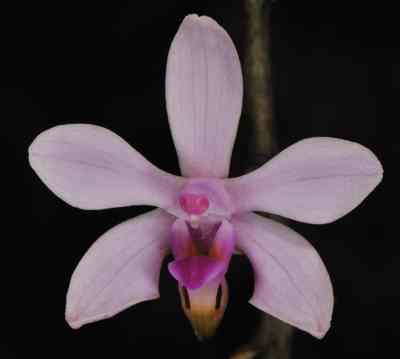Epiphyte. A plant with a solitary pendulous leaf and numerous spreading, flat roots running into meters. Leaf elliptic-oblong, sessile, tapering to its base, 3 to 7 cm long and 1 to 2 cm in width. Flowers in racemes, longer than the leaves, pendulous, 5 to 9 flowered. Flowers small, 1 to 1.5 cm across. Sepals and petals are pale pink, the epichile of the lip and anther are dark punk, the base of the spur with a faint yellow shade. Sepals unequal, the dorsal lanceolate, the lateral broader than the dorsal, undulate on one side. Petals obovate to spathulate. Both sepals and petals five nerved. Lip adnate to the foot of the column, its hypochile turned into a stout sub-cylindric spur and with two narrow lobes, the epichile oblong, entire.

The Pursuit
This species got long and flat root network, often forming large clusters. In the winter months when most of the trees shed their leaves, its root network can be easily spotted. I spotted the species in the winter months because of this reason. By the early spring, leaf appears on this plant, a single pendulous leaf, from the centre of the root network. Then within a few days a pendulous raceme. I was making a visit to the location every week to ascertain its status. The authors in their monumental work mentioned about the plants producing white flowers too. However, till date there is no photographic evidence for that. Hence, I was looking for more plants from the region, to make sure I would get flowers in white. The search ended up with not much success as I was not able to find more plants from that area. With the start of early monsoon showers, the buds opened. The flowers were so beautiful, but its peculiar lip shape made the documentation time consuming and needed more technical skills than expected. There were seven flowers on the raceme I selected to document. I tried with the lower most flower on the raceme on the first day. Even after several attempts I was not getting the result I desired. The position of the pendulous flowers were also not providing a good opportunity for me to position my flashes. The day ended with much disappointment. Next day I started the journey to the location by Sunrise, determined to rectify the defects of the previous day. The location was around 7400 ft high, deep inside a forest, hence there will always be fog and slight shower. As I was about to reach there, it rained heavily and made my last stretch of trek impossible. One more day ended up on a dissatisfactory mode. The third was a bright day and I reached the place around 8 in the morning to find one more raceme in bloom on another tree. Decided to try to document those flowers and with the help of a local cattle herder, who helped me with holding six micro flashes between his short fingers, produced this wonderful photograph. However, my hunt for those white flowers of this species is still continuing.